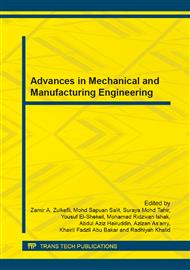[1]
M.R. Forouzan, M.R. Niroomand, S.J. Golestaneh, S.A.R. Tabatabaiee. Optimization of residual stresses o welding process of large diameter oil and gas pipes. 15th Annual (International) Conference on Mechanical Engineering (ISME 2007), Tehran, Iran (2007).
Google Scholar
[2]
M.R. Forouzan, S.M. Mirfalah Nasiri, A. Mokhtari, A. Heidari, S.J. Golestaneh: Materials & Design (2012) Vol. 33, pp.384-94.
DOI: 10.1016/j.matdes.2011.04.016
Google Scholar
[3]
M.R. Forouzan, M.R. Niroomand, A. Heidari, S.J. Golestaneh. Constrained Optimization of the Submerged Arc Welding Process of Oil and Gas Pipes by TAANGA Method. 2nd Iranian pipe & pipeline conference, Tehran, Iran (2009).
Google Scholar
[4]
S.J. Golestaneh, N. Ismail, S.H. Tang, M.K.A.M. Ariffin, H.M. Naeini, A.A. Maghsoudi: International Journal of the Physical Sciences (2011) Vol. 6, pp.7935-49.
Google Scholar
[5]
J. Antony, R.B. Anand, M. Kumar, M.K. Tiwari: Journal of Manufacturing Technology Management (2006) Vol. 17, pp.908-25.
Google Scholar
[6]
H.H. Chang: Expert Systems with Applications (2008) Vol. 35, p.1095–103.
Google Scholar
[7]
S. Kumanan, J.E.R. Dhas, K. Gowthaman: Indian Journal of Engineering & Materials Sciences (2007) Vol. 12, pp.177-83.
Google Scholar
[8]
A.W.L. Yao, H.T. Liao, C.Y. Liu: The Open Automation and Control System Journal (2008) Vol. 1, pp.7-13.
Google Scholar
[9]
E. Del Castillo, D.C. Montgomery, D.R. Mccarviille: Journal of quality technology (1996) Vol. 28, pp.337-45.
Google Scholar
[10]
D. Lepadatu, A. Kobi, R. Hambli, A. Barreau. RAMS 2005 IEEE. (2005).
Google Scholar
[11]
S.H.R. Pasandideh, S.T.A. Niaki: Applied Mathematics and Computation (2006) Vol. 175, p.366–82.
Google Scholar
[12]
I. Mukherjee, P.K. Ray. International Journal of Intelligent Systems Technologies and Applications (2008) Vol. 4, pp.97-122.
Google Scholar
[13]
Information from Sadid pipe and equipments co., Tehran, Iran, http: /www. sadidpipe. com.
Google Scholar
[14]
M.R. Forouzan, A. Heidari, S.J. Golestaneh. Esteghlal journal (2009) Vol. 28, pp.93-110.
Google Scholar
[15]
T. Kamo, C. Dagli: Expert Systems with Applications (2009) Vol. 36, pp.5023-30.
Google Scholar
[16]
Matlab User's Guide. Version 2012b. Neural Network Toolbox Math Works, USA. Vol. (2012), p.
Google Scholar
[17]
H.B. Celikoglu: Mathematical and Computer Modelling (2006) Vol. 44, p.640–58.
Google Scholar
[18]
E. Ardil, P.S. Sandhu: International Journal of Physical Sciences (2010) Vol. 5, pp.074-85.
Google Scholar
[19]
J. Bo, T. Yuchun, Z. Yan-Qing: International Journal of Computational Intelligence in Bioinformatics and Systems Biology (2009) Vol. 1, p.59.
Google Scholar
[20]
N. Ismail, S.J. Golestaneh, S.H. Tang, M.K.A.M. Ariffin, H. Moslemi Naeini, D. Rouhani. Modified committee neural networks for prediction of machine failure times. The 3rd national intelligent systems and information technology symposium (ISITS 2010), Institute of Advanced Technology (ITMA), Universiti Putra Malaysia (UPM)-Malaysia (2010).
DOI: 10.35940/ijeat.a3025.109119
Google Scholar
[21]
A. Kadkhodaie-Ilkhchi, M.R. Rezaee, H. Rahimpour-Bonab. Persian Gulf. Journal of Petroleum Science and Engineering (2009) Vol. 65, pp.23-32.
DOI: 10.1016/j.petrol.2008.12.012
Google Scholar
[22]
K.Y. Benyounis, A.G. Olabi, M.S.J. Hashmi: Optics & Laser Technology (2008) Vol. 40, pp.76-87.
Google Scholar
[23]
H. -H. Chang, Y. -K. Chen: Applied Soft Computing (2011) Vol. 11, p.436–42.
Google Scholar
[24]
A. Haghizadeh, l. Teang shui, E. Goudarzi. Australian Journal of Basic and Applied Sciences (2010) Vol. 4, pp.1668-75.
Google Scholar
[25]
P. Krause, D.P. Boyle, F. Bäse. Advances in Geosciences (2005) Vol. 5, p.89–97.
Google Scholar


